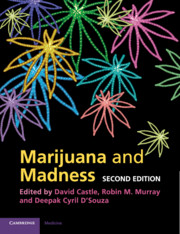
- Cited by 3
-
Cited byCrossref Citations
This Book has been cited by the following publications. This list is generated based on data provided by Crossref.
Haobam, Mary Mohanty, Rakesh Senjam, Gojendra and Heramani, Ningombam 2017. Cannabis and its associated psychopathology. Journal of Medical Society, Vol. 31, Issue. 3, p. 143.
Sankaranarayanan, Anoop Wilding, Helen Neill, Erica and Castle, David 2018. A Critical Systematic Review of Evidence for Cannabinoids in the Treatment of Schizophrenia. Psychiatric Annals, Vol. 48, Issue. 5, p. 214.
Dasram, Mendhi Henna Naidoo, Pavesan Walker, Roderick B. and Khamanga, Sandile M. 2024. Targeting the Endocannabinoid System Present in the Glioblastoma Tumour Microenvironment as a Potential Anti-Cancer Strategy. International Journal of Molecular Sciences, Vol. 25, Issue. 3, p. 1371.
- Publisher:
- Cambridge University Press
- Online publication date:
- November 2011
- Print publication year:
- 2011
- Online ISBN:
- 9780511706080
- Subjects:
- Psychiatry and Clinical Psychology, Medicine, Psychiatry




